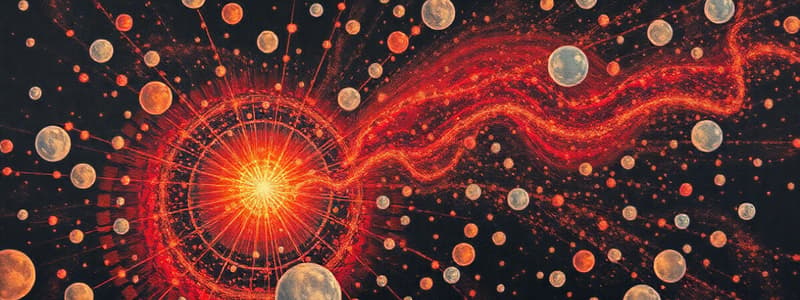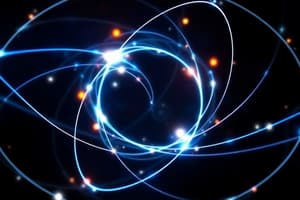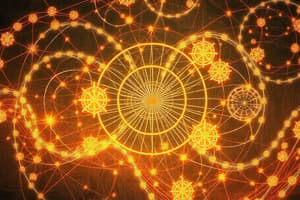Podcast
Questions and Answers
Richard Feynman's work on Quantum Electrodynamics (QED) at Cornell University involved exploring interactions of electromagnetically charged particles. Which of the following best describes what QED explains at a fundamental level?
Richard Feynman's work on Quantum Electrodynamics (QED) at Cornell University involved exploring interactions of electromagnetically charged particles. Which of the following best describes what QED explains at a fundamental level?
- The movement of celestial bodies through space-time.
- The gravitational forces between particles.
- The exchange of photons, or quanta, of electromagnetic energy between charged particles. (correct)
- The strong nuclear force within atomic nuclei.
Feynman's experience with university admissions reveals biases that existed during his time. What specific barrier did he encounter that affected his admission to Columbia University?
Feynman's experience with university admissions reveals biases that existed during his time. What specific barrier did he encounter that affected his admission to Columbia University?
- The university had already filled its quota for Jewish students. (correct)
- His focus on physics rather than a broader range of scientific disciplines.
- He did not meet the minimum age requirement for admission.
- His lack of prior research experience in mathematical theories.
Feynman's early aptitude and interests played a role in his career choices. Which of the following best describes his childhood and early academic inclinations?
Feynman's early aptitude and interests played a role in his career choices. Which of the following best describes his childhood and early academic inclinations?
- He showed a talent for working with gadgets and a capacity for mathematics, experimenting with mathematical theories in high school. (correct)
- He demonstrated an early talent for literature and creative writing.
- He was primarily interested in history and political science.
- He focused on mastering classical languages and ancient civilizations.
Richard Feynman contributed to the Manhattan Project due to concerns about the potential outcome of World War II. What motivated him to join this initiative?
Richard Feynman contributed to the Manhattan Project due to concerns about the potential outcome of World War II. What motivated him to join this initiative?
Feynman's groundbreaking work led to significant recognition later in his career. Which honor did he receive jointly with others in 1965?
Feynman's groundbreaking work led to significant recognition later in his career. Which honor did he receive jointly with others in 1965?
Feynman is noted for his ability to make complex subjects accessible. How are his teaching abilities reflected in the materials he produced at Caltech?
Feynman is noted for his ability to make complex subjects accessible. How are his teaching abilities reflected in the materials he produced at Caltech?
Richard Feynman's work spanned various areas within physics, including his contributions during wartime. In what capacity did he participate in the Manhattan Project?
Richard Feynman's work spanned various areas within physics, including his contributions during wartime. In what capacity did he participate in the Manhattan Project?
Feynman's appointment at Cornell University marked a pivotal moment in his career. What area of study did he primarily focus on as a professor of theoretical physics at Cornell?
Feynman's appointment at Cornell University marked a pivotal moment in his career. What area of study did he primarily focus on as a professor of theoretical physics at Cornell?
Feynman's academic path included a significant achievement during his graduate studies. What accomplishment set him apart when he took the graduate entrance exams for Princeton University?
Feynman's academic path included a significant achievement during his graduate studies. What accomplishment set him apart when he took the graduate entrance exams for Princeton University?
Richard Feynman is described as having made esoteric subjects seem engaging and entertaining. Which field of study exemplifies this aspect of his work?
Richard Feynman is described as having made esoteric subjects seem engaging and entertaining. Which field of study exemplifies this aspect of his work?
How did Feynman's diagrams contribute to the understanding of particle behavior in quantum electrodynamics (QED)?
How did Feynman's diagrams contribute to the understanding of particle behavior in quantum electrodynamics (QED)?
What was the significance of Feynman's work with 'partons' in the context of later developments in particle physics?
What was the significance of Feynman's work with 'partons' in the context of later developments in particle physics?
In what way did Feynman's approach to explaining complex phenomena, such as the Challenger disaster, reflect his broader communication style?
In what way did Feynman's approach to explaining complex phenomena, such as the Challenger disaster, reflect his broader communication style?
How did Feynman's contributions influence the application and accessibility of Quantum Electrodynamics (QED) in theoretical physics?
How did Feynman's contributions influence the application and accessibility of Quantum Electrodynamics (QED) in theoretical physics?
What aspect of Feynman diagrams addresses the challenges of calculations in quantum mechanics, particularly with regard to possible outcomes?
What aspect of Feynman diagrams addresses the challenges of calculations in quantum mechanics, particularly with regard to possible outcomes?
What is implied by Feynman's statement, 'I think I can safely say that nobody understands quantum mechanics?'
What is implied by Feynman's statement, 'I think I can safely say that nobody understands quantum mechanics?'
How did Murray Gell-Mann's model contribute to the standard model of particle physics?
How did Murray Gell-Mann's model contribute to the standard model of particle physics?
Why is Feynman's work on superfluidity considered significant in the field of physics?
Why is Feynman's work on superfluidity considered significant in the field of physics?
What is the primary use of Feynman diagrams by particle physicists today?
What is the primary use of Feynman diagrams by particle physicists today?
In what specific way did Feynman's diagrams clarify the nature of electron and photon interactions?
In what specific way did Feynman's diagrams clarify the nature of electron and photon interactions?
Flashcards
Richard Feynman
Richard Feynman
Exceptional physicist and inspirational teacher known for making quantum theory engaging and his work in subatomic ideas.
Manhattan Project
Manhattan Project
A nuclear-weapons program during WWII that Feynman participated in at Los Alamos, New Mexico.
Quantum Electrodynamics (QED)
Quantum Electrodynamics (QED)
Feynman's main area of research. Describes interactions of electromagnetically charged particles via photon exchange.
Nobel Prize in Physics
Nobel Prize in Physics
Signup and view all the flashcards
Feynman Lectures on Physics
Feynman Lectures on Physics
Signup and view all the flashcards
Albert Einstein Award
Albert Einstein Award
Signup and view all the flashcards
Feynman Diagrams
Feynman Diagrams
Signup and view all the flashcards
Quantum Probabilities
Quantum Probabilities
Signup and view all the flashcards
Role of QED
Role of QED
Signup and view all the flashcards
Subatomic particle model
Subatomic particle model
Signup and view all the flashcards
Quarks
Quarks
Signup and view all the flashcards
Superfluidity
Superfluidity
Signup and view all the flashcards
Nanotechnology
Nanotechnology
Signup and view all the flashcards
Quantum Computing
Quantum Computing
Signup and view all the flashcards
Study Notes
- "I think I can safely say that nobody understands quantum mechanics" - Richard Feynman, 1964
Quantum Probabilities
- Feynman had a talent for communicating complex ideas in intuitive ways for the QED theory
- 1948: Feynman formulated a version of the theory that produced meaningful results using Feynman diagrams
- Feynman diagrams are useful graphics illustrating the concepts of electrons and photons moving in both time and space.
- The particles in Feynman's diagrams could move forward or backward in time.
- Feynman's diagrams are a mathematical model where the probabilities of all possible events are added up.
- Many probabilities cancel each other, leaving answers that make sense in real-world terms.
- QED is a strange theory of light and matter
- Electrons are depicted by straight lines in Feynman diagrams, while photon exchange between electrons is shown by wavy lines.
- Feynman diagrams are shorthand for extremely complicated equations.
- Today, particle physicists use them in a range of applications, including calculating outcomes of events in particle accelerators such as the Large Hadron Collider in Switzerland.
- QED became one of the most successful theories in physics, and was adopted as the model for theories of other basic forces, such as the nuclear force, due to Feynman's input
Nanotechnology and Superfluidity
- Feynman proposed a theory of "partons," a precursor to the modern concept of quarks
- Feynman helped introduce nanotechnology.
- Feynman theorized about the future existence of quantum computing.
- Feynman explained why, when cooled to absolute zero, helium flows without viscosity (internal friction).
- 1986: Feynman formed part of a team investigating the Challenger disaster
- The NASA space shuttle exploded seconds after lift-off, killing all seven members of its crew.
- Feynman demonstrated that the Challenger disaster happened using just a glass of icy water and a piece of rubber.
- Feynman diagrams depict the most abstract concepts in physics while looking like charming squiggles.
- Feynman decorated his yellow RV with Feynman diagrams.
- The simplicity of Feynman diagrams reflects Feynman's flair for explaining complex ideas, which was made into a textbook from his physics lectures at Caltech that proved extremely popular
Murray Gell-Mann
- Murray Gell-Mann (1929-) was able to conceive the modern system for classifying subatomic particles
- 1964: Gell-Mann proposed a model for classifying the different types of subatomic particles
- He distinguished two main groups of particles: fermions, the building blocks of matter; and bosons, which are force-carriers.
- Gell-Mann invented a hypothetical fundamental unit called the "quark"
- Quarks are a type of fermion that group together to form hadrons (protons and neutrons).
- The quark was isolated using a particle accelerator, proving Gell-Mann's model correct
- Gell-Mann won the 1969 Nobel Prize in Physics
- Gell-Mann's model is what is now known as the "standard model."
- Gell-Mann was the group leader in the Theoretical Division at Los Alamos aged 24
- Accurately described particle interactions to 15 decimal places
Studying That Suits You
Use AI to generate personalized quizzes and flashcards to suit your learning preferences.





